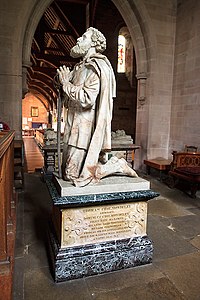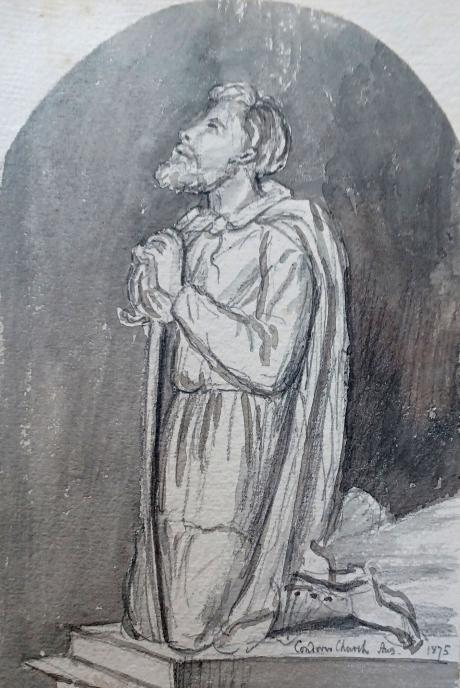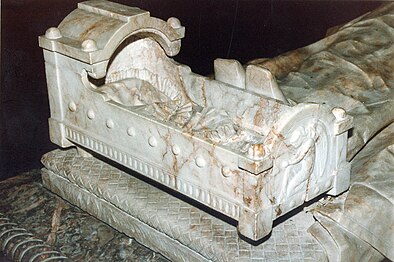inscribed and dated "Condover Church 1875" and signed with initials "LWT"
Tom and Laura Taylor and thence by descent
Reginald Cholmondeley JP DL (20 April 1826 – 10 February 1896) of Condover, Shropshire, was an English landowner, artist and collector. He was a Justice of the Peace and Deputy Lieutenant of Shropshire and held the rank of Major, 1st Batt. 28th Salop Royal Volunteers. The Condover estate passed to him on the death of his brother, Thomas, in 1864.

Cholmondeley was born on 20 April 1826 at Hodnet, the third son of Charles Cowper Cholmondeley (1795–1831) of Chester, rector of Hodnet, Shropshire and Mary Heber (d. 1846). His eldest brother, Thomas, was a Major of the first Administrative Battalion of the Shropshire Rifle Volunteers; another brother, Charles, was a Catholic priest; his youngest brother was the Reverend Richard Hugh, the rector at Hodnet, whose daughter was the novelist Mary Cholmondeley.
He attended Trinity College, Cambridge where he matriculated in 1845, obtaining a B.A. in 1849, M.A. in 1856 and was admitted at the Inner Temple on 18 January 1850, but not called. He trained as a painter and sculptor in the 1850s.

In March 1863, following the death of his cousin, Edward William Smythe Owen (1793–1863), Thomas Cholmondeley (1823–1864) inherited Condover Hall and the large estate adjacent, and took the name of Owen as a condition of the inheritance. A year later he married Victoria Alexandrina Cotes, daughter of John Cotes and Lady Louisa Jenkinson, daughter of Charles Jenkinson, later 3rd Earl of Liverpool and a godchild of Queen Victoria. He travelled to Italy for his wedding tour and in Florence he was "seized with a malignant fever" on 10 April and died there on 20 April 1864. His brother, Reginald, who had met him in Florence, carried back his remains to England, and he is buried in Condover churchyard.
In the parish church at Condover there is a marble monument to Thomas Cholmondeley by George Frederic Watts (1817–1904), featuring a kneeling bearded figure of the deceased, wearing boots, a cloak and a soldier's tunic, with his hands clasping a sword, looking out across the choir stalls in front of him, into the chancel.
The Condover estate devised to Reginald on the death of his brother, Thomas, in March 1864. His country seat, Condover Hall, is generally regarded as "the finest stone manor-house in Shropshire." He also owned a house in London. Originally in single occupation as No. 37 Palace Gate, this large red-brick house at the corner with Canning Place was built in about 1869–70 for Reginald Cholmondeley, to whom Cubitts granted a ninety-nine-year lease from September 1870, at £100 per annum. The architect was Frederick Pepys Cockerell, who also worked for Cholmondeley on the restoration of his country seat, Condover Hall, Shropshire. As well as being a considerable landowner, Cholmondeley was an enthusiastic amateur sculptor of some accomplishment. Many of the elaborate sculptural decorations at Condover Hall are his work.

On 17 October 1867 at Rostherne, Cholmondeley married Alice Mary Egerton (1836–27 November 1868), daughter of William Egerton, 1st Baron Egerton of Tatton and Charlotte Elizabeth Loftus, daughter of John Loftus, 2nd Marquess of Ely. His younger brother, the Reverend Richard Hugh Cholmondeley, officiated at the ceremony.
His new wife was an artist and a poet and the couple were well-suited but the marriage would be short-lived. Alice died in childbirth on 27 November and was buried on 3 December 1868; her infant daughter, Alice, died three weeks after her mother, on 11 December and was buried on 19 December in the parish church at Condover.
In the Church of St Mary and St Andrew, Condover, there is a very affecting monument to Alice Cholmondeley that was sculpted by her husband of one year. It features a recumbent effigy of Alice, with her infant daughter by her side and an empty cradle at her feet.
Cholmondeley also sculpted the recumbent effigy of his cousin, Blanche Heber (d. 1870), at St Luke's Church, Hodnet.
In 1871 he published Poems by A.C., a volume of poems by his late wife and dedicated to Robert Browning, and in 1875, Emblems, a volume of her drawings. A presentation copy of the latter was given to the banker, George Rae.
-
Monument to Alice Cholmondeley by Reginald Cholmondeley, Church of St Mary and St Andrew, Condover
-
Monument to Alice Cholmondeley (detail)
-
Monument to Alice Cholmondeley (detail)

Cholmondeley was "a man of powerful personality and fine taste", an accomplished artist and talented amateur sculptor as well as an enthusiastic collector of books, manuscripts, paintings and curiosities. He had exhibited at the Royal Academy and counted many of London's artists such as G.F. Watts and John Everett Millais (1829–1896) as personal friends.
His circle of friends also included the poet and playwright, Robert Browning (1812–1889), poet, biographer and translator, Sir Theodore Martin (1816–1909), whose portrait he painted, and Lady Martin as well as the American writer, Mark Twain (1835–1910) and his wife, who visited Condover in 1873 and 1879.
On 2 July 1881 (the day that President Garfield was shot) Olivia Clemens received from their friend Reginald Cholmondeley a letter of condolence on the death of her husband in Australia; startling enough, though in reality rather comforting than otherwise, for the reason that the "Mark Twain" who had died in Australia was a very persistent impostor.
When he wrote to Twain to apologise for the mistake the humourist graciously replied:
"Being dead I might be excused from writing letters, but I am not that kind of a corpse. May I never be so dead as to neglect the hail of a friend from a far land."
-
Condover Hall, engraving by E.I. Roberts after J.P. Neale
-
Condover Hall, south-west view
-
Condover Hall, front view
Cholmondeley owned a number of rare books as well as valuable paintings, among them Elizabethan, Old Masters and many more; armour and Birds of Paradise that he purchased from the ornithologist, John Gould.

The most important books in his library were:
- Nicholas Cox, The Gentleman's Recreation, 1674
- Robert William Eyton, The Antiquities of Shropshire, 1854–1860
- Oliver Goldsmith, The Vicar of Wakefield, 1766
- Jean de la Fontaine, Contes et Nouvelles, 1762
- Longus, Les Amours Pastorales de Daphnis et Chloe, 1745
- George Stanhope, Parson's Christian Directory, 1716
- Dean Swift, Gulliver's Travels, 1726
- Voltaire, Œvres, 1735
- Horace Walpole, The Castle of Otranto, 1791
- Las Quarto Libros de Amadis de Gaula, 1533
- Richard Hakluyt, Principal Navigations, Voyages, and Discoveries of the English Nation, 1589
- Carl Schütz; Johann Ziegler, Vues de la Ville de Vienne et de Vues en Tyrol, Styrie, 1785
- An imperfect copy of the first folio Shakespeare, 1623
- David Wilkins, Concilia Magnæ Britanniæ et Hiberniæ, 1737
- Documents letters and papers written by the lawyer and antiquary, John Smith of North Nibley, Gloucestershire, steward of Henry Berkeley, 7th Baron Berkeley (1534–1613) and MP for Midhurst, Sussex in 1621. There is a well-filled volume of notes made by Smith when he sat in Parliament but they do no contribute anything beyond what is already known.
- A fine early copy (on a roll of parchment) of the poem called The Stacions of Rome, giving an account of the various churches and shrines at Rome, of the relics there, and the indulgences consequent on visits to them.
- Collections of the 18th-century, by the physician and antiquary, William Cowper (1701–1767), of Overleigh Hall, Chester, for the history and antiquities of Chester and the Isle of Man. Cowper's niece, Dorothy Cowper, married Thomas Cholmondeley (1726–1779) of Vale Royal, bringing with her the Overleigh estate. She was Reginald Cholmondeley's great-grandmother.
- Sanctus Tewdricus sive Pastor Bonus. A Latin drama, with illuminated title page by Henry Matthew Chamberling
16th-century and 17th-century portraits of English kings, queens and courtiers, including:
- Henry VIII
- Mary I
- Elizabeth I
- Charles I
- Henrietta Maria
- Jane Seymour
- Thomas Seymour, 1st Baron Seymour of Sudeley: Thomas Seymour, Baron Seymour, 16th century, by unknown artist
- ?Elizabeth Seymour: Unknown woman, formerly known as Catherine Howard, late 17th-century, after Hans Holbein the Younger
- William Cecil, 1st Baron Burghley
- Richard Foxe, Bishop of Winchester
- Henry Fitzalan, 12th Earl of Arundel
- Henry Pole, 1st Baron Montagu
- Henry Sidney: Sir Henry Sidney, 1573, by unknown artist
- Francis Walsingham
-
Sir Henry Sidney, 1573, by unknown artist
-
Thomas Seymour, Baron Seymour, 16th century, by unknown artist
-
Unknown woman, formerly known as Catherine Howard, late 17th-century, after Hans Holbein the Younger
- Paintings by William Dobson, Thomas Lawrence, Godfrey Kneller, Philip James de Loutherbourg, George Stubbs, Anthony van Dyck,
- George Frederic Watts:
- ?A Study with the Peacock's Feathers, c. 1862–1865
- Paolo and Francesca, 1872 and
- Francesco Zuccarelli.
- Paintings by Juliette Peyrol Bonheur and Antoine Watteau.
- Paintings by Paul Bril, Pieter Casteels, Lucas Cranach the Elder, Lucas de Heere, Jan Gossaert, Daniël Mijtens and others.
- Paintings by Claudio Coello, Bartolomé Esteban Murillo, Juan Pantoja de la Cruz,
- Antonis Mor: Elisabeth de Valois, 1560,
- Jusepe de Ribera, Diego Velázquez, Federico Zuccaro and Francisco de Zurbarán.
- Paintings by Leandro Bassano, Jacopo Bellini, Boccaccio Boccaccino, Agnolo Bronzino, Canaletto,
- Antonio Maria Vassallo: The Larder, probably c. 1650–1660,
and others.
- A painting by Paolo Veronese
-
?A Study with the Peacock's Feathers, c. 1862–1865, George Frederic Watts.
-
Paolo and Francesca, 1872, George Frederic Watts.
-
Elisabeth de Valois, 1560, by Antonis Mor
-
The Larder, probably c. 1650–1660, by Antonio Maria Vassallo
By the 1890s Cholmondeley found himself in debt as a result of his extravagance. Over the years he had spent on Condover Hall, its contents and gardens, what was needed for the estate, which became "so neglected and encumbered" that he was planning to sell it when he died in 1896.
He died on 10 February 1896 at Condover Hall and was buried on 13 February in the parish church at Condover.
The Condover estate passed to his younger brother, the Reverend Richard Hugh Cholmondeley (1828–1910).
The Condover estate and the collections of books, paintings, furniture and armour were sold in 1897.
The Condover estate was purchased in 1897 by Edward Fielden, who later sold it in 1926.
Laura Wilson Barker (6 March 1819 – 22 May 1905), was a composer, performer and artist, sometimes also referred to as Laura Barker, Laura W Taylor or "Mrs Tom Taylor".
She was born in Thirkleby, North Yorkshire, third daughter of a clergyman, the Rev. Thomas Barker. She studied privately with Cipriani Potter and became an accomplished pianist and violinist. As a young girl Barker performed with both Louis Spohr and Paganini. She began composing in the mid-1830s - her Seven Romances for voice and guitar were published in 1837. From around 1843 until 1855 she taught music at York School for the Blind. During this period some of her compositions - including a symphony in manuscript, on 19 April 1845 - were performed at York Choral Society concerts.
On 19 June 1855 she married the English dramatist, critic, biographer, public servant, and editor of Punch magazine Tom Taylor. Barker contributed music to at least one of her husband's plays, an overture and entr'acte to Joan of Arc (1871), and provided harmonisations as an appendix to his translation of Ballads and Songs of Brittany (1865).
Her other works include the cantata Enone (1850), the violin sonata A Country Walk (1860), theatre music for As You Like It, (April 1880), Songs of Youth (1884), string quartets, madrigals and solo songs. Her choral setting of Keats's A Prophecy, composed in 1850, was performed for the first time 49 years later at the Hovingham Festival in 1899. The composer was present.
Several of Barker's paintings hang at Smallhythe Place in Kent, Ellen Terry's house.
Barker lived with her husband and family at 84 Lavender Sweep, Battersea. There were two children: the artist John Wycliffe Taylor (1859–1925), and Laura Lucy Arnold Taylor (1863–1940). The Sunday musical soirees at the house attracted many well-known attendees, including Lewis Carroll, Charles Dickens, Henry Irving, Charles Reade, Alfred Tennyson, Ellen Terry and William Makepeace Thackeray.
Tom Taylor died suddenly at his home in 1880 at the age of 62. After his death, his widow retired to Porch House, Coleshill in Buckinghamshire, where she died on 22 May 1905, aged 86.








![Sir Henry Sidney, 1573, by unknown artist[42]](https://upload.wikimedia.org/wikipedia/commons/thumb/c/cc/Henry_Sidney.jpg/324px-Henry_Sidney.jpg)
![Thomas Seymour, Baron Seymour, 16th century, by unknown artist[34][35]](https://upload.wikimedia.org/wikipedia/commons/thumb/0/0f/Thomas_Seymour%2C_Baron_Seymour_from_NPG.jpg/331px-Thomas_Seymour%2C_Baron_Seymour_from_NPG.jpg)
![Unknown woman, formerly known as Catherine Howard, late 17th-century, after Hans Holbein the Younger[36][37]](https://upload.wikimedia.org/wikipedia/commons/thumb/d/df/Unknown_woman%2C_formerly_known_as_Catherine_Howard_by_Hans_Holbein_the_Younger.jpg/270px-Unknown_woman%2C_formerly_known_as_Catherine_Howard_by_Hans_Holbein_the_Younger.jpg)
![?A Study with the Peacock's Feathers, c. 1862–1865, George Frederic Watts.[46]](https://upload.wikimedia.org/wikipedia/commons/thumb/2/26/George_Frederic_Watts_-_Girl_with_Peacock_fan.jpg/280px-George_Frederic_Watts_-_Girl_with_Peacock_fan.jpg)
![Paolo and Francesca, 1872, George Frederic Watts.[47]](https://upload.wikimedia.org/wikipedia/commons/thumb/8/8a/Watts-Paolo_and_Francesca.jpg/289px-Watts-Paolo_and_Francesca.jpg)
![Elisabeth de Valois, 1560, by Antonis Mor[51]](https://upload.wikimedia.org/wikipedia/commons/thumb/c/c9/Elisabeth_de_Valois%2C_Anthonis_Mor.jpg/272px-Elisabeth_de_Valois%2C_Anthonis_Mor.jpg)
![The Larder, probably c. 1650–1660, by Antonio Maria Vassallo[53][54]](https://upload.wikimedia.org/wikipedia/commons/thumb/9/9b/The_Larder_E-001128-20120221.jpg/243px-The_Larder_E-001128-20120221.jpg)